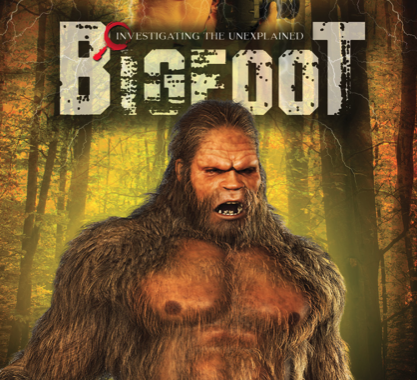
Mystery in the Night
Maribel and Robert hike deep into the wilderness. They are far from any cities or roads. The pair finds a clearing in the thick forest and sets up camp. They keep their cameras close at hand. Bigfoot could appear at any moment!
As night falls, the investigators pull gear from their packs. Robert’s night-vision goggles are at the ready. Maribel flips the switch to turn on her audio recorder. Then they wait. Minutes tick by slowly, and Maribel begins to doze off.
Suddenly, distant screeches echo through the forest. Robert gasps as a rustling in the bushes draws close. “Shh!” Maribel whispers and lifts her recorder high in the air. A skunky smell fills the clearing.
Robert peers into the darkness through his goggles. Maribel scrambles for the camera. A large shadow moves among the trees and disappears into the night. In the morning, the Bigfoot hunters search the area. Maribel snaps photos of a large footprint on the soft ground. Was Bigfoot here?
Secrets of the Forest
Some people believe that a large primate, an intelligent mammal with hands and feet, roams North America’s thick, distant forests. They call this mysterious cryptid Bigfoot, or Sasquatch. Cryptids may or may not exist in real life. Native American stories of Bigfoot go back hundreds of years. Many of these tales describe Bigfoot as peaceful.
Most researchers believe that Bigfoot is not one creature but a species, meaning there are multiple of them. The creatures are said to walk upright on two legs and have human-like faces. But witnesses claim they are much taller and heavier than humans. Hair covers much of their bodies. Many early reports of Bigfoot came from the Pacific Northwest. But sightings have been reported across the United States and Canada!
One Big Mystery
In 1811, British explorer David Thompson found strange tracks in the Canadian Rockies. He described them in his journal. Some people believe this is the earliest record of Bigfoot footprints. More Bigfoot stories arrived in the late 1800s and onward. One man even claimed a Bigfoot family kidnapped him!
The Bigfoot mystery struck Northern California in 1958. There, a construction worker found large footprints around his tractor. A newspaper named the footprints' creator “Bigfoot.” Many years later, the worker’s children claimed that the prints had been faked. Still, many believe the tracks were real.
News of the 1958 tracks spread across the United States. Bigfoot investigators rushed to California. They wanted to prove this mysterious creature existed. Millionaires from Texas and Ohio even got involved. They organized searches led by well-known monster hunters such as Peter Byrne.
Investigators brought cameras, hoping for photos and videos of Bigfoot. They kept plaster on hand to create casts, or molds, of tracks. With camping gear, investigators could spend weeks in Bigfoot’s forest home. By the 1990s, off-road vehicles allowed them to travel through thick forests in search of the creature.
In 1967, two investigators claimed they filmed Bigfoot in California. The grainy video became famous! Two years later, a trail of 1,089 tracks appeared in snowy northern Washington. The detailed prints seemed to reveal a deformed right foot. Sightings continued to pop up around North America.
Investigators considered these discoveries evidence that Bigfoot existed. In time, Bigfoot organizations formed. These groups studied Bigfoot tracks and sightings. They also held conferences. There, Bigfoot hunters shared their experiences and compared methods.
Profile: The Patterson-Gimlin Film
In the fall of 1967, Roger Patterson and Bob Gimlin set out for the thick wilderness of northern California. Stories of Bigfoot encounters drew them there to film a documentary. On October 20, Patterson and Gimlin spotted a hairy creature walking across a clearing. In one minute, it was gone. But Patterson had captured it on film!
Hollywood costumers, special effects experts, and scientists have studied the video. Some claim it is a hoax, but that has never been proven.
Searching for Bigfoot
Modern investigators pack a mix of old and new gear. Notebooks are still key for logging Bigfoot encounters. Plaster remains another major tool. Casts allow Bigfoot hunters to study prints at home. They can compare them to other tracks and study them for anatomical details, allowing them to discover parts that makeup the body of Bigfoot.
Investigators often use small plastic bags to store possible Bigfoot evidence, such as hair or blood. Scientists test this for DNA. If a sample does not match any known DNA, it might be from Bigfoot!
No Bigfoot kit is complete without cameras. Investigators need video and still cameras to record any live encounters. But cameras are also handy when researchers find footprints, droppings, or other Bigfoot evidence. They take photos so they can closely examine this evidence later.
Modern cameras capture high-quality photos and videos. They can take hundreds of photos at a time. Some investigators also hide trail cameras deep in the forest. These cameras start recording when they sense movement nearby.
Investigators believe that Bigfoot is most active at night. Night-vision goggles allow investigators to see in the dark. Thermal cameras pick up body heat from nearby animals. They then show that heat on screen. This helps investigators record creatures lurking in the forest.
Investigators do not just look for Bigfoot. They listen, too. Bigfoot is said to knock on trees, howl, and whistle. Parabolic microphones let investigators capture these sounds from far away. Some researchers even try to copy those noises to attract Bigfoot. They use their own voices as tools!
Sasquatch Skeptics
Most scientists are not convinced that Bigfoot is real. They question how such a large animal could stay hidden for so long. They also point out that nobody has dug up Bigfoot bones or teeth. How could evidence of a giant primate be missing from the North American fossil record?
Many people claim to have spotted Bigfoot. Yet skeptics do not trust these sightings. They argue that witnesses may confuse seeing a bear or another known animal with Bigfoot.
Skeptics also believe that people have faked evidence of Bigfoot to earn money and fame. They point out that Bigfoot tracks come in different sizes and shapes. People could easily create phony Bigfoot feet to make fake tracks. They could also fake Bigfoot noises.
Even images of Bigfoot do not sway skeptics. They point out that photos and videos of Bigfoot are often blurry. Experts can often identify when a person is in costume. Sometimes evidence is digitally altered.
Bigfoot Believers
There have been thousands of Bigfoot sightings. Many people have also found footprints, hair, and other evidence of Bigfoot. Still, nobody has been able to prove these creatures exist.
Even so, the mystery of Bigfoot continues to fascinate people. Websites and television shows are dedicated to finding the creature. More investigators and rapidly improving technology mean that discovering Bigfoot is becoming more likely. If Bigfoot exists, it may not be long before the truth comes out.



 About BeeLine
About BeeLine